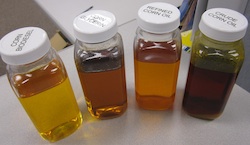The Advanced Biofuels Leadership Conference held in Washington, D.C. last week was a meeting of the minds. During one of the sessions on hot technologies, Jeffrey Stroburg, Chairman and CEO of REG, gave a presentation on advanced partnership strategies for development and commercialization. REG has been the driver in helping to commercialize corn oil extracted from the back end of a corn ethanol plant. I was able to sit down with him for a few minutes after his presentation to get more information about the process to commercialize emerging feedstocks.
 Stroburg said that the biodiesel industry in the United States started off with the idea to use soybean oil. At the time, the industry felt like soybean prices were stable enough and that it would create a good feedstock.
Stroburg said that the biodiesel industry in the United States started off with the idea to use soybean oil. At the time, the industry felt like soybean prices were stable enough and that it would create a good feedstock.
“Little did we know that we’d go into such volatility not just in soybean oil, but in all commodities,” said Stroburg. “Which led us to believe that we needed to have a wider suite of products that we could go to so that if one was not economic, we would have another we could go to. And the cheaper the feedstock, it seems like, the harder it is to convert. We then had to increase our capabilities and improve our technology so that we could convert some pretty junky stuff. That has given us the opportunity to go into a number of different markets to try to source feedstocks.”
Listen to my full interview with Jeffrey Stroburg: Developing Partnerships for Biodiesel Feedstocks
One of the emerging feedstocks is inedible corn oil but Stroburg said it is difficult to convert.
“There are some things in corn oil that we don’t see in other feedstocks. So we had to develop some equipment specifically designed to convert corn oil. But the thing that is driving corn oil is that the economics are there for the ethanol producers. By taking the oil out of the back end of their process, it makes their co-products more valuable. So a DDG (dried distillers grain) that has the oil taken out of it, at least in certain markets, is more valuable. So it increases the value of the DDG and they get so many cents per pound for the oil,” explained Stroburg.
 I asked Stroburg, “If the growers grow it, can you convert it to biodiesel in an economically feasible way? I threw out possible future feedstocks including pennycress, camelina, mustard seed, jatropha.
I asked Stroburg, “If the growers grow it, can you convert it to biodiesel in an economically feasible way? I threw out possible future feedstocks including pennycress, camelina, mustard seed, jatropha.
He answered, “We can produce ASTM biodiesel with everything you mentioned. But whether or not it’s going to be commercially viable or not goes clear back to the farmer whose going to plant it in the ground. Can he get enough tonnage per acre to make it worth his time or is he better off planting potatoes? And then the other part of it is what’s the convertibility of that feedstock. They all convert at different levels. So I think we have to look at both aspects. Can we get enough return on the land and still have a product that can convert and compete with other fuels.”
Ultimately, Stroburg believes that jatropha is a ways away but that there are some emerging opportunities with camelina.
Click here to see my Flickr photos album from the Advanced Biofuels Leadership Conference.

